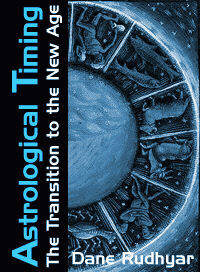 |
| Home | Bio | Art | Music | Literature | Civilization & Culture | Philosophy of Wholeness | Theosophy & Spirituality | Astrology |

ASTROLOGICAL TIMING
The Transition to the New Age by Dane Rudhyar, 1969 First published under the title Birth Patterns for a New Humanity
CONTENTS
PROLOGUE Where Do We Stand Today? PART ONE 1. Three Centuries of Crisis 2. Planetary Cycles 3. Cycles of Relationship PART TWO 4. Stars, Constellations and Signs of the Zodiac 5. From Buddha to Christ 6. The Structure of the Piscean Age Page 1 Page 2 Page 3 Page 4 Page 5 Page 6 Page 7 7. At the Gates of the New Age 8. The Aquarius-Leo Age PART THREE 9. The Zodiacal Earth-Field 10. As We Face the Future EPILOGUE |

CHAPTER SIX
The Structure of the Piscean Age - 3 VII. 982 to 1162 AD The Crusades begin in 1096. In this "seventh House phase" of the Piscean Age, East and West begin to interpenetrate again. French noblemen are in the lead and establish various feudal kingdoms in and around Syria. As they return to France, they bring back with them the seeds of the "spiritual Renascence" of the XlVth and XVth centuries which preceded the "intellectual Renaissance" of the XVIth century. These French noblemen not only take Eastern wives, but mingle with mystic brotherhoods (Sufis, Druses and other groups) — for which they are condemned by the Pope. Then are formed the great Knightly Orders, such as the Knights Templars (founded in 1119 AD by Hugues de Payns and Godeffroi de St. Omer), the knights of the Order of the Hospital of St. John of Jerusalem (with Raymond du Puy as their most famous leader, 1120 AD), and later the Teutonic Order (whose origin dates from 1128, when a German pilgrim and his wife started a hospital on the shores of Palestine). VIII. 1162 to 1342 AD German, English and French kings lead Crusades against the Turks who, under the great Kurd ruler, Saladin, had reconquered several Islamic countries and Jerusalem. These Crusades (from the third to the seventh) ended with the abandonment of the Holy Land by the Christians (1291) and the eastward spread of the Turks (Mamelukes) who finally conquered Constantinople in 1453 — thus ending the Eastern Empire begun under Constantine the Great (330 AD) During this strange and tumultuous period, the greatest beauty and fervor blend with the shadows of a feudal and theocratic society. It is the time of the Gothic cathedrals and of chivalry, but also of the ruthless suppression of spiritual-occult groups such as the Albigenses (who were heirs, in South-West France, to a great Gnostic tradition) and the Templars (who knew too much and had become spoiled by wealth — wealth the French king badly needed!). It saw the rise of the Universities, and the works of great encyclopedical minds such as Roger Bacon, St. Thomas Aquinas, Dante and many Christian mystics, Alchemists and astrologers — and of equally brilliant thinkers in Syria and the Near East, and also India. But it saw also the beginnings of the Inquisition around 1220 — just at the time of the English Magna Charta and of the Swiss Confederacy, first steps toward "democracy." During these two centuries powerful political leaders arose, from Frederic Barbarossa to the great Mogol Khans, and the struggle between the Papacy and the Germanic Emperor was pursued relentlessly. The growth of mercantile cities in Germany (Hanseatic League, etc.) and Italy established the foundations for the eventual development of bourgeoisie and world-wide trade. To interpret this Gothic period in terms of the different levels of eighth-House symbolism is to gain a new insight into its essential character. That "medievalism" is still today synonymous with fanaticism and ignorance merely indicates how deep is our bondage to the concepts of the Renaissance — and it is not a too fortunate bondage! The Age of Scholasticism and of Chivalry is obviously not to be taken as an ideal model for the future society; yet, in its universalism and its insistence upon spiritual values, in its youthful enthusiasm for coherent learning and for creative group-expression, in its heroic venture someness and its bold artistic conceptions, the Middle Ages period, from 1000 to 1250, stands out as an extraordinary and fascinating epoch. It is indeed truly a seventh and eighth period within the span of the Piscean Age because its keynote is the transformation of human relationships and of society on the basis of a spiritual and universalistic (encyclopedical) vision. And nothing characterizes this keynote better than the spirit of chivalry. By permission of Leyla Rudhyar Hill Copyright © 1969 by Dane Rudhyar and Copyright © 2001 by Leyla Rudhyar Hill All Rights Reserved.  Web design and all data, text and graphics appearing on this site are protected by US and International Copyright and are not to be reproduced, distributed, circulated, offered for sale, or given away, in any form, by any means, electronic or conventional. See Notices for full copyright statement and conditions of use. Web design copyright © 2000-2004 by Michael R. Meyer. All Rights Reserved. |
 |